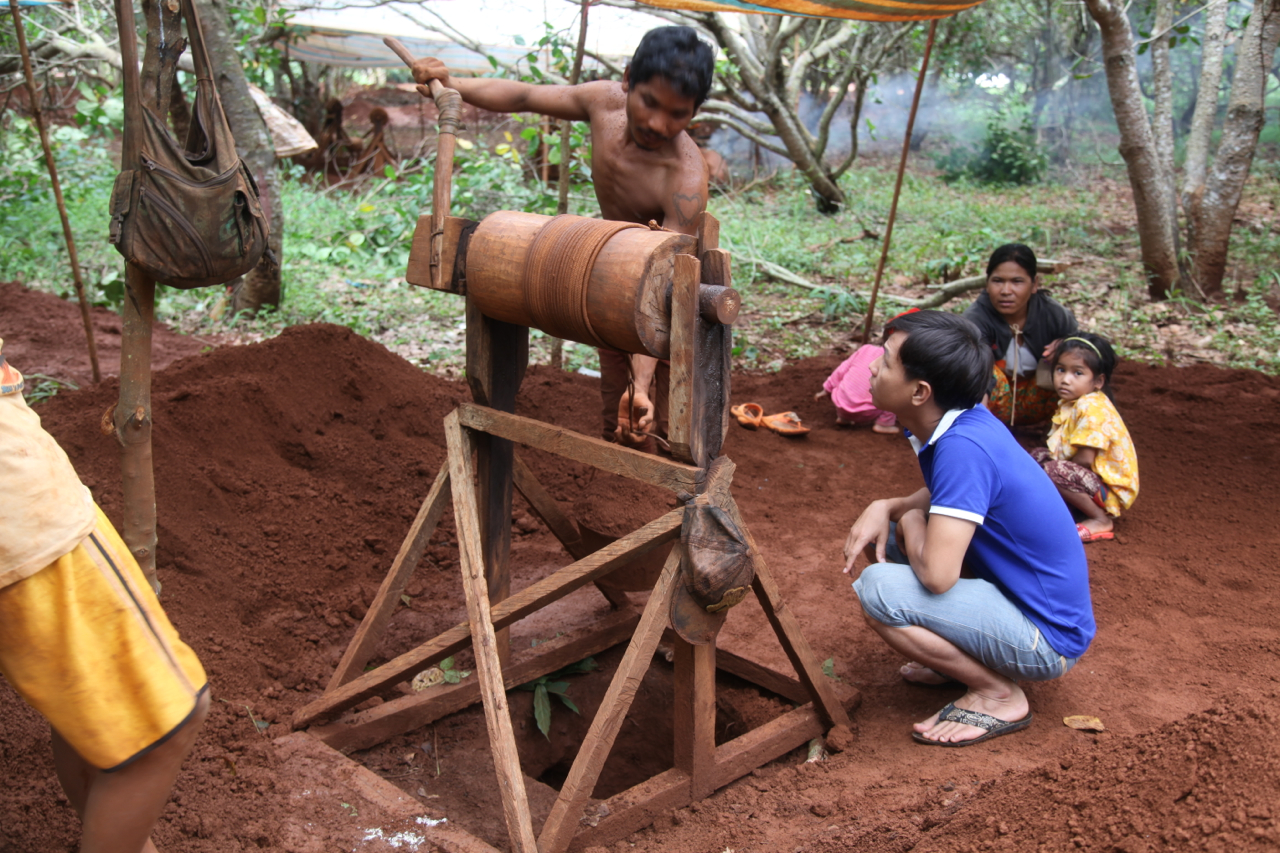
ការរុករករ៉ែហ្សីកខននៅខេត្តរតនគិរី រូបថត ដោយក្រុមការងារអង្គការទិន្នន័យអំពីការអភិវឌ្ឍ កាលពីខែកញ្ញា ឆ្នាំ២០១៤។ ក្រោមអាជ្ញាប័ណ្ណ៖ CC BY-NC-ND 2.0
មិនមានការរុករកត្បូង ជាលក្ខណៈឧស្សាហកម្មខ្នាតធំឡើយនៅក្នុងប្រទេសកម្ពុជា ហើយក៏មានកម្មករត្បូងអចិន្ត្រៃយ៍តិចតួចផងដែរ។ ប្រជាជនភាគច្រើន ធ្វើជាកម្មករត្បូងខណៈពេលធ្វើការងារផ្សេងទៀត–ដែលជាទូទៅ ជាការងារកសិដ្ឋាន–ហើយពួកគេភាគច្រើនធ្វើការរ៉ុករកត្បូងដោយគ្មានអាជ្ញាប័ណ្ណ។ អ្នកប្រកបរបររ៉ុករកត្បូងជាញឹកញយមានជីវភាពក្រីក្រ។ ប្រតិបត្តិការជាទូទៅមានសភាពក្រៅផ្លូវការ។ ត្បូងជាច្រើនត្រូវបានលក់ទៅឱ្យឈ្មួញមកពីប្រទេសថៃ ឬប្រទេសវៀតណាម។ មិនមានស្ថិតិអាចទុកចិត្តបានណាមួយស្តីអំពីតម្លៃ ឬបរិមាណនៃត្បូង ដែលត្រូវបានរ៉ុករកនៅក្នុងប្រទេសកម្ពុជាក្នុងឆ្នាំនីមួយៗនោះទេ។
មានរ៉ែត្បូងជាច្រើនប្រភេទ ត្រូវបានរកឃើញនៅក្នុងប្រទេសកម្ពុជា។ ប្រភេទត្បូងដែលមានតម្លៃបំផុត គឺត្បូងទទឹម និង កណ្តៀង។ទន្ទឹមនឹងនេះ មានត្បូងពណ៌បៃតង ត្បូងអាហ្វីម៉ាទ្រីន ត្បូងជម្ពូរ័ត្ន ត្បូងពណ៌លឿង ត្បូងតូប៉េស ត្បូងគុជក្រហម ថ្មក្រានីត ហ្សីកខន និងត្បូងឬថ្មប្រភេទផ្សេងទៀតក៏ត្រូវបានរកឃើញផងដែរ។មិនមាន ត្បូងពេជ្រឬត្បូងមរកតត្រូវបានរកឃើញនៅក្នុងប្រទេសកម្ពុជានោះទេ។ មានការរ៉ុករកត្បូងកណ្តៀង និងត្បូងទទឹមនៅប៉ៃលិនយ៉ាងច្រើនលើសលុបក្នុង ទសវត្សរ៍ឆ្នាំ ១៩៧០ នេះជាមូលហេតុធ្វើឱ្យមានត្បូងធំៗនៅសេសសល់ក្នុងចំនួនតិចតួចមកទល់នឹងពេលសព្វថ្ងៃ។1 តំបន់សំខាន់ៗសម្រាប់ការរុករកត្បូងថ្មមាននៅខេត្តប៉ៃលិន (ត្បូងទទឹមនិងត្បូងកណ្តៀង) ខេត្តរតនៈគីរី (ត្បូងហ្សីកខន) ខេត្តតាកែវ (ត្បូងតូប៉េស រ៉ែត្បូងខៀវ ត្បូងអាហ្វាម៉ាទ្រីន) ខេត្តកំពង់ធំ (ត្បូងជម្ពូរ័ត្ន) ខេត្តព្រះវិហារ (ត្បូងកណ្តៀង) និងខេត្តមណ្ឌលគីរី (ត្បូងព័ណស្លែ)។ ត្បូងថ្មក្នុងបរិមាណច្រើនដែលដាក់លក់ក្នុងទីផ្សារកម្ពុជាត្រូវបាននាំចូល ដែលភាគច្រើនមកពីប្រទេសថៃ ឥណ្ឌា មីយ៉ាន់ម៉ា និងប្រទេសខាងទ្វីបអាហ្វ្រិក។
ច្បាប់ស្តីពីការរុករករ៉ែ
ច្បាប់ស្តីពីការគ្រប់គ្រង និងប្រើប្រាស់ធនធានរ៉ែ (“ច្បាប់ស្តីពីការរ៉ុករករ៉ែ ”) បានបញ្ជាក់ថា ធនធានរ៉ែទាំងអស់ គឺជាសម្បត្តិរដ្ឋ។2 មានអាជ្ញាប័ណ្ណរ៉ុករករ៉ែសរុបចំនួន៦ប្រភេទនៅក្រោម ច្បាប់រុករករ៉ែនៅកម្ពុជា ហើយ១ប្រភេទក្នុងចំនោមនោះ គឺជាអាជ្ញាប័ណ្ណរុករកត្បូងថ្ម។ការធ្វើប្រតិបត្តិការរុករករ៉ែបែបឧស្សាហកម្មដោយគ្មាន អាជ្ញាប័ណ្ណជាអំពើខុសច្បាប់ ហើយទង្វើនេះអាចទទួលរងការផ្តន្ទាទោសដោយការផាកពិន័យឬជាប់ពន្ធនាគារ។
លោក ហ៊ុន ប៊ុនថន ប្រធានការិយាល័យនៃក្រសួងរ៉ែ និងថាមពល នៅខេត្តរតនគិរី បានរាយការណ៍ថា ពលរដ្ឋដែលមានកម្មសិទ្ធិដីធ្លីមានសិទ្ធិក្នុងការជីកអណ្តូងរ៉ែរហូតដល់ជម្រៅ៥ម៉ែត្រនៅលើដីរបស់ខ្លួន។ បើអណ្តូងជីកជ្រៅជាងការកំណត់នេះ នឹងតម្រូវឱ្យមានច្បាប់អនុញ្ញាត្តិជាកំហិត។3
ការរ៉ុករករ៉ែដោយគ្មានអាជ្ញាប័ណ្ណគឺជា រឿងធម្មតាណាស់។4អ្នកសម្របសម្រួលឱ្យអង្គការអាដហុកម្នាក់បានរាយការណ៍ថា មានអណ្តូងរាប់ពាន់ដែលមានជម្រៅ ១០ម៉ែត្រនៅក្នុងស្រុកបរកែវ ខេត្តរតនគិរី។ អ្នកស្រុកដែលត្រូវបានជួលឱ្យធ្វើការជីក និងស្វែងរករ៉ែត្បូងហ្សីកខនបានរាយការណ៍ថា ការជីកក្នុងមួយថ្ងៃអាចឱ្យពួកគេអាចរកប្រាក់ចំណូលបានពី ៥,០០០-១០,០០០រៀល (ប្រមាណ១.២៥-២.៥០ដុល្លារ) ប៉ុន្តែប្រសិនបើពួកគេរកឃើញត្បូងល្អ នោះពួកគេអាចទទួលបានប្រាក់ជាង ៣០,០០០ រៀលឬ ៧.៥០ដុល្លារ ។5 ការរុករករ៉ែប្រភេទនេះប្រឈមនឹង គ្រោះថ្នាក់ ហើយកម្មករអាចនឹងស្លាប់នៅពេលអណ្តូងដែលពួកគេកំពុងជីកបាក់ស្រុត។ ភាគច្រើននៃការរុករករ៉ែប្រភេទនេះ ត្រូវបានអនុវត្តដោយជនជាតិដើមភាគតិចនៅបរកែវ និងមានបុរសជនជាតិដើមភាគតិចទំពួនម្នាក់បានស្លាប់ខណៈពេលរុករករ៉ែ កាលពីក្នុងខែកក្កដា ឆ្នាំ២០១៤។6
ធ្វើបច្ចុប្បន្នភាពចុងក្រោយនៅថ្ងៃទី២៨ ខែតុលា ឆ្នាំ២០១៥
ឯកសារយោង
- 1. ហ៊ុល រស្មី, ‘ជីវិតរស់នៅយ៉ាងលំបាកលើលានរ៉ែត្បូងប៉ៃលិន’, ការសែតដឺខេមបូឌាដេលី, ថ្ងៃទី១១ ខែមិថុនា ឆ្នាំ២០១៤។ https://www.cambodiadaily.com/archives/scraping-out-a-living-in-pailins-spent-gem-mines-61043/
- 2. ច្បាប់គ្រប់គ្រងនិងប្រើប្រាស់ធនធានរ៉ែ, មាត្រាទី២.
- 3. សេន ដេវីត, ‘ឈ្មួញទិញត្បូងប្រាប់ឱ្យឈប់រកត្បូងទៅ’, ការសែតភ្នំពេញបុស្តិ៍, ថ្ងៃទី២៤ ខែវិច្ជិការ ឆ្នាំ២០១៤។
- 4. សេន ដេវីត,ដូចខាងដើម
- 5. សេន ដេវីត,ដូចខាងដើម
- 6. គុត សុភក្ត្រចរិយា, ‘ពាណិជ្ជកម្មដោយប្រថុយប្រថាន៖កម្មករត្បូងត្រូវបាន សម្លាប់បន្ទាប់ពីការរកត្បូងអស់រយៈពេលច្រើនថ្ងៃ’, ការសែតភ្នំពេញបុស្តិ៍, ថ្ងៃទី៣០ ខែកក្កដាឆ្នាំ២០១៤ http://www.phnompenhpost.com/national/risky-business-gem-miner-killed-after-day-farming

